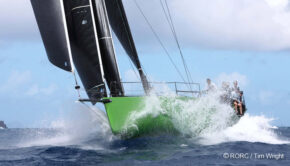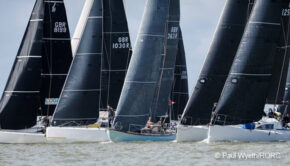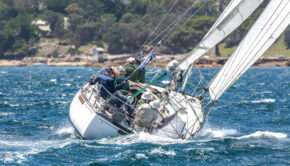Optimism for a better future
Published on June 8th, 2020
At its introductory level, handicapping systems provide the opportunity for dissimilar boat to meet and compete together. But as the stakes rise, so has the complexity, and it hasn’t always been a smooth ride. For Seahorse magazine, Dobbs Davis relives the trip and offers optimism for a better future:
As it was in the rest of the competitive racing world, the culture of measurement and measurement-based handicap ratings in the USA was really at its peak in the last few decades of the 20th century.
The CCA, then the IOR rating systems, established the framework for measurement parameters and protocols, which were later refined in the 1980s and ’90s from single-point hull measures to characterize hull shapes and volumes to be replaced by 3D surfaces.
Measurements of spars and sails also evolved with the trends in improving technologies.
Sometimes the rules kept up with these trends and other times remained a little too slow to embrace, leading to some controversial if not amusing ‘optimizations’ (think Krazy K-Yote or Sunstone), driven by the intense competitiveness of the offshore team regattas like the Admiral’s, Sardinia, Kenwood and Southern Cross Cup events.
The level Ton classes and later the ILC classes also placed a heavy premium on meeting exacting design and measurement standards to stay within the defined boxes. Designers and competitive teams learned how to push the limits to their extreme, sometimes stepping over the line of legality that threatened to swallow some high-profile teams in scandal.
Remember Seymour Sinnett’s Williwaw skippered by Dennis Conner, Burt Keenan’s Acadia, and Tom Dreyfus’s Louisiana Crude in the 1981 SORC?
Measurement controls discovered that all three had gross discrepancies in their measured trim at the regatta compared to their certificate data, and were thus dismissed from their membership of that year’s US Admiral’s Cup team.
(Seahorse editor: It was later discovered that all three yachts had been IOR measured some 800lb-1,600lb heavier than in racing condition by virtue of extra gear and water that was hidden away onboard… and which the measurers failed to spot).
News of this breach appeared in the major newspapers of the day, with Angus Phillips in the Washington Post calling it “an unprecedented scandal in yacht racing, dealing with the heart of the sport.” He also wrote:
“The sad thing is that the official measurers had to be a part of this. If, in fact, they did a good job of measuring the boats in the first place, these irregularities would be impossible to effect. Whatever happened had to happen during the measuring. Everyone knows there’s some cheating in the measuring system. It just got out of hand.”
Yikes – really? “Everyone knows there’s some cheating in the measuring system”???
Well, regardless of the veracity of that bold claim, IOR and later IMS were popular and used in every major sailing region, so there was a broad network of local measurers able to gather the data and report it to the national rating authority to issue certificates.
This became especially important in the 1970s, the heydays of competitive IOR racing, when new boats were being built with great frequency from established race boat design firms like S&S, Ted Hood, German Frers, Dick Carter, and C&C in Canada.
Yet there was also enough high demand to launch the career of numerous younger US-based designers like Doug Peterson, Bill Tripp, Bruce Nelson and Bruce Marek, John Reichel and Jim Pugh, Bruce Farr (well, a Kiwi transplanted to Annapolis), Carl Schumacher, Ron Moore, Bill Lee, George Olson, Scott Graham and Eric Schlageter, Alan Andrews, Jim Taylor, and many more.
These rules often evolved quickly as loopholes were discovered and exploited by designers of so-called ‘rule-beaters,’ who had (and still have) better computational tools than the rule-makers and therefore could create designs that might enjoy one season of success followed by mediocrity as the holes were recognized and plugged to preserve the competitiveness and balance of the fleet.
Yet the whole game centered around measurement, and there were plenty of tricks that helped ratings without being against the rules: like taking freeboards in fresh water to make your boat look heavier on its certificate, knowing it would be campaigned in salt water – fortunately nowadays we measure the specific gravity of water to deal with and eliminate this particular effect!
As the boat designs evolved and rating tools also shifted to ensure fairness to protect against the ‘rule-beaters’, more sophisticated measurements were needed along with the skills and accuracies of the measurers. A turning point came in the UK with the advent of measurement rule simplicity with the IR 2000 initiative, and to this day IRC measures remain straightforward with the rule policy itself handling nuances in design around known typeforms.
In the US, however, the racing fleets became widely diverse, there was less tolerance for annual rule changes and the rapid obsolescence of existing boats, and the VPP rules were not keeping up very well.
So in the late ’90s the advent and immense popularity of offshore one-designs siphoned off the most serious players, and the number of new designs raced under handicap started dwindling.
There were exceptions on the West Coast with the offshore ULDB designs, with many of these migrating to the Midwest to race there, and the continued interest among cruiser/racers who participated in the classic offshore races on the East Coast.
The real impact of this shift was felt at the club and regional levels, where the use of the measured rules nearly disappeared in favor of the empirical PHRF system that is governed by local committees. Even the large popular events – like Key West Race Week – for years had only one-designs and PHRF classes.
So, the need for measurers diminished to only where its need was tied to the location of a major offshore race: the Mexican and Transpac races on the West Coast, the Mac races in the Midwest, and the Bermuda and similar races in the Northeast.
The introduction of IRC in the US brought a spike in measurement interest 15 years ago as boats started getting weighed rather than inclined, but this too tapered off as US certificate counts dropped from 1,000 ten years ago to now stabilizing around the 200 mark.
Recent promotion of ORC in the US has also generated a little bump in interest but a resulting certificate count around 300 is hardly a threat to a relatively vast PHRF fraternity.
In 2020, however, a waning of one-design classes, further fleet diversity and local rebellions against PHRF has revived the interest in a solid measurement-based handicap system. The ORC/IRC World Championship planned for the fall in Newport also prompted a uplift in interest in measurement.
Accordingly a UMS Measurement Seminar was recently held in Annapolis to present concepts and best practices to an enthusiastic group of 25 certified and aspiring measurers from all around the US and Canada, as well as from AUS and NZL.
Aside from a seminar subsidized by SYRF in the brief days of HPR several years ago, this was the first gathering of this kind in the US focused solely on big boat measurement within memory.
For three full days, both ORC and IRC rules and techniques were explained, demonstrated and debated at the US Naval Academy and Severn Sailing Association, with ORC underwriting the expense of the event.
World Sailing vice president Gary Jobson also came to provide his long view of the historically important role handicapping and measurement has played in the sport, and how it will now also become relevant to the Olympics as the interest in double-handed racing grows and countries make their selection processes where there is no ready use of one-design classes.
Since the complexity of the VPP rules require more measurements, much of the seminar’s content was presented by Nathan Titcomb of US Sailing and ORC chief measurer Zoran Grubisa, while Jason Smithwick from the RORC rating office also made the trip to demonstrate IRC measurement.
These three have been working together for nearly three years under the UMS banner to consolidate as much as possible the measurements used by the two systems – for sails this is nearly complete and already ORC software is being programmed to accept IRC measurements as well as being able to produce IRC measurements from ORC data.
Indeed after years of unspoken rivalry, in Annapolis there was a welcome feeling of both collaboration and enthusiasm across the various rating constituencies. Co-operation is good…
Note: Seahorse, the dominant international magazine for anyone serious about their racing, is available by magazine subscription or iPad download: www.seahorse.co.uk/shop









 We’ll keep your information safe.
We’ll keep your information safe.